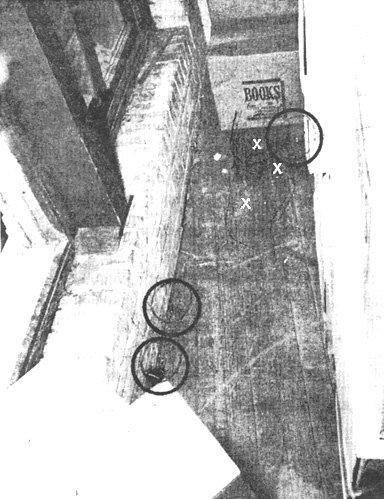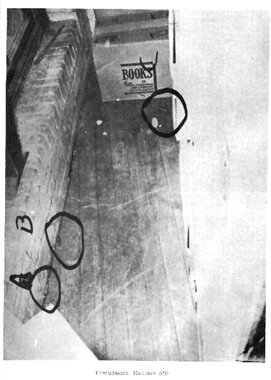 Dark Corners Menu |
 "Sniper's Nest" Menu |
 Dark Corners Menu |
 "Sniper's Nest" Menu |
by Allan Eaglesham
|
3.2. Cartridge Cases -- The Broken Chain of Evidence When the call went out that the "sniper's nest" had been discovered, police Captain Will Fritz and Tom Alyea were only 20 to 30 feet away (see Figure 24). Alyea followed Fritz, and described the discovery of three shell casings as follows [16]: The casings were clustered inside the enclosure...I filmed them from the window box position but did not enter the enclosure...The lowest box in the barricade allowed me to look over and see the casings below, but I was not able to film them while looking through the viewfinder of the camera. I set my lens at five feet and held the camera over the box and got my shot...(A)ll three casings could have been covered by a small hand towel...I asked Captain Fritz if I could go behind the barricade and get a close up of the casings. He said "No," and proceeded to enter the enclosure, gather up the casings, and hold them over the low box for me to get my close-up shot...He did not return them to the floor, but turned and walked toward the boxes at the shooting site and visually examined the placement and view down Elm Street. It appears that, in order to assist the newsman obtain a close-up of the cartridge cases, Captain Fritz compromised the crime scene and handled vital evidence in cavalier fashion -- possibly smudging fingerprints on the cartridge cases. The approximate locations of the cartridge cases when seen by Mr. Alyea, from his memory, are shown in Figure 26 in conjunction with their official locations. Alyea has described them as "bunched" within "an area of two feet" [9]. Shadow angles are consistent with Detective Studebaker's statement that the photograph in Figure 26 (same view as in Figure 14) was taken on the afternoon of 11/22/63. |

|
Regarding when and by whom the cartridge cases were replaced, apparently randomly, on the floor, Alyea said [12]:
I never saw the casings again after Fritz put them in his pocket. Obviously he gave them to Studebaker when Studebaker was led to the sniper's nest, with the instructions to include them in shots of the crime scene. Fritz did not go with Studebaker, he stayed with us, watching Day dusting the rifle. After the discovery of the "sniper"s nest," Captain Fritz assigned two uniformed officers to guard the location, then ordered a search of the seventh floor, which yielded nothing of interest. At this point, Alyea removed the roll of film from his movie camera and dropped it to a locked-out colleague; within 20 minutes, pictures from the sixth floor were flashed around the world. However, without Alyea's explanation of the film footage, its enormous significance went largely unrecognized; Alyea later discovered that key shots were edited out and lost [18]. He never saw the footage of the undisturbed "sniper's nest," of the cartridge cases on the floor, or of the cartridge cases in Fritz's hand. Captain Fritz's account of the discovery of the "sniper's nest" was as follows, from his testimony to the Warren Commission [19]: Q: Then what did you do? In a subsequent affidavit, Captain Fritz saw the need to repeat what surely was standard procedure and second nature to law-enforcement officers -- hardly worthy of mention -- to leave a crime scene untouched until processed by crime-laboratory detectives [20]: When the officers called me to this window, I asked them not to move the shells nor touch them until Lt. Day of the Dallas Police Department could make pictures of the hulls showing where they fell after being ejected from the rifle. The routine aspect of leaving the putative crime scene untouched was a recurring theme in the testimony of policemen involved in the TSBD search [21]. It is noteworthy that Captain Fritz felt it necessary also to spell out that the cartridges had been ejected from the rifle; perhaps he felt the need to scotch any rumors that Detective Studebaker had tossed them onto the floor! Sheriff's Deputy Luke Mooney corroborated Tom Alyea's account of Fritz picking up the cartridge cases. During Mooney's testimony for the Warren Commission, his questioner, Joseph A. Ball, posed a blatantly leading question with reference to the chain of evidence for the cartridge cases: Q: Those were empty shells? His choice of words -- "I stood there and watched him" -- suggests surprise, if not shock. Although Mr. Ball seemed to expect Deputy Mooney to say that someone other than Fritz had picked up the empty shells, the news that Fritz himself had gone over and picked them up elicited no response. In the questioning of other police officers, much emphasis was given to who collected the cartridge cases and the chain of evidence, yet the issue of Captain Fritz boldly stepping into the crime scene and handling evidence was unworthy of follow-up questions. Instead: Q: Is this the position of the cartridges as shown in 510 (Figure 27), as you saw them? |

|
After this tortuous exchange, which demonstrated that Deputy Mooney did not recognize the positions of the cartridges as seen in CE 510, Mr. Ball came up with the non-sequitur of the year:
Q: You think that the cartridges are in the same position as when you saw them in this picture 510? And the witness almost succumbed to this coercion: A: As far as my knowledge, they are; pretty close to right...Just from my memory, it seems that this cartridge ought to have been over this way a little further. That was the end of the subject. Mr. Ball did not invite Mr. Mooney to mark on the photograph where he thought "B" should have been located. It is noteworthy that the Deputy Sheriff not only corroborated Tom Alyea's account of Captain Fritz compromising the crime scene, but he also placed two of the three cartridges in the same general area as did Alyea. In affidavits for the Warren Commission, Lieutenant Day stated that he and Detective Richard M. Sims picked up the cartridge cases at about 1:20 PM and placed them in an envelope; after Day processed them for fingerprints, Sims took possession of them [22]. One might think that key events of that terrible day would be indelibly impressed in the memories of those involved. Taking possession of the cartridge cases of the bullets assumed to have killed the President of the United States would surely have been a seminal experience. Yet, Detective Sims was vague and uncertain in his Warren Commission testimony [23]: Q: Who picked up the hulls? This confused exchange suggests that Mr. Sims was relying less on his memory of the events than on his memory of what he had been told to say. Captain Fritz, although significantly older than Detective Sims, exhibited a better memory in an affidavit [24]: After the pictures were made, Detective R.M. Sims of the Homicide Bureau, who was assisting in the search of building, brought the three empty hulls to my office. These were delivered to me in my office at the police headquarters. I kept the hulls in an envelope in my possession and later turned them over to C.N. Dhority of the Homicide Bureau and instructed him to take them to Lt. Day of the Identification Bureau. One has to wonder if these were the same casings that Captain Fritz himself had picked up and pocketed. The Mannlicher-Carcano rifle found on the sixth floor of the TSBD was examined for its pattern of cartridge-case ejection by Robert Frazier, a firearms expert with the FBI. The tests showed that cartridges were ejected at angles ranging from 68 to 97 degrees [25]). When shown the photographs in Figures 14 and 15, Mr. Frazier concurred, in his Warren Commission testimony, that if the rifle had been fired from that window, the locations of the cartridge cases were consistent with the results of his tests to determine the ejection patterns [26]. If Mr. Frazier had been shown the photograph in Figure 11 and had been told that the rifle trajectory was 45 degrees towards the southwest, I wonder if he would have similarly concurred. It is ironic that the results from Mr. Frazier's tests indicate that casings ejected from the rifle fired by an assassin in the official "sniper's nest," as illustrated in Figure 11, would have struck the east surface of the stacked cartons and not ricocheted between the stacked cartons and the south wall. Notes |
| Previous Section | Next Section |
